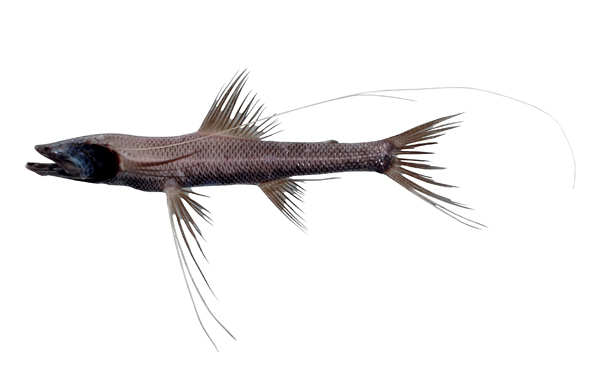Abyssal Spiderfish, Bathypterois longipes Günther 1878
Other Names: Spider Fish

Abyssal Spiderfish, Bathypterois longipes. Source: Australian National Fish Collection, CSIRO. License: CC by Attribution-NonCommercial
Cite this page as:
Bray, D.J. 2022, Bathypterois longipes in Fishes of Australia, accessed 10 Jul 2025, https://fishesofaustralia.net.au/home/species/3325
Abyssal Spiderfish, Bathypterois longipes Günther 1878
More Info
|
Distribution |
Coral Sea east of Gladstone, Queensland, to east of Bermagui, New South Wales; also the Lord Howe Rise in the Tasman Sea. Elsewhere the species is circumglobal in abyssal waters. |
|
Biology |
Spiderfishes (family Ipnopidae) are simultaneous hermaphrodites. Individuals have an ovotestis containing functional male and female reproductive tissue. |
|
Remarks |
Individuals prop tripod-like on their long pelvic and caudal fin rays, raising their bodies off the seafloor. They face into the current, extending their long sensory pectoral fins forward to detect the movement of zooplankton such as small crustaceans that drift by in the current. Underwater ROV images have shown the trails made when these fishes 'walk' over the seafloor on their pelvic fins and lower tail fin lobe. |
|
Etymology |
The specific name longipes is from the Latin longus (= long) and pes (= foot), in reference to the “much prolonged” outer pelvic-fin ray. |
|
Species Citation |
Bathypterois longipes Günther 1878, Annals and Magazine of Natural History 5 2(2, 22, 28): 184. Type locality: Off Uruguay, 36°44'S, 46°16'W, Challenger station 325, depth 2650 fathoms. |
|
Author |
Bray, D.J. 2022 |
|
Resources |
Abyssal Spiderfish, Bathypterois longipes Günther 1878
References
Günther, A. 1878. Preliminary notices of deep-sea fishes collected during the voyage of H.M.S. Challenger. Annals and Magazine of Natural History 5 2(2, 22, 28): 17-28, 179-187, 248-251 See ref at BHL
Lörz, A.N., Berkenbusch, K., Nodder, S., Ahyong, S., Bowden, D., McMillan, P., Gordon, D., Mills, S. & Mackay, K. 2012. A review of deep-sea benthic biodiversity associated with trench, canyon and abyssal habitats below 1500 m depth in New Zealand waters. New Zealand Aquatic Environment and Biodiversity Report No 92. 133 pp
Merrett, N.R. 1992. Demersal ichthyofaunal distribution in the abyssal eastern North Atlantic, with special reference to Coryphaenoides (Nematonurus) armatus (Macrouridae). Journal of Marine Biological Association of the United Kingdom 72(1): 5-24.
Merrett, N.R. & Fasham, M.J.R. 1998. Demersal ichthyofaunal distribution in the abyssal North Atlantic revisited: the effect of sample size on ordination. Marine Ecology Progress Series 173: 267-274.
Nielsen, J.G. 1979. Bathypteroidae. pp. 164-165. In Hureau, J.C. & Monod, Th. (eds) Check-list of the fishes of the north-eastern Atlantic and of the Mediterranean (CLOFNAM). UNESCO, Paris. Vol. 1.
Nunoo, F., Poss, S., Russell, B. & Bannerman, P. 2015. Bathypterois longipes. The IUCN Red List of Threatened Species 2015: e.T190243A15603030. http://dx.doi.org/10.2305/IUCN.UK.2015-4.RLTS.T190243A15603030.en. Downloaded on 19 February 2018.
Nybelin, O. 1957. Deep-sea bottom fishes. Reports of the Swedish Deep-Sea Expedition 2 (Zoology No. 20): 250-345.
Shcherbachev, Yu.N., Kukuev, E.I. & Shlibanov, V.I. 1985. Composition of the benthic and demersal ichthyocenoses of the submarine mountains in the southern part of the North Atlantic Range. Journal of Ichthyology 25: 110-125.
Sulak, K.J. 1977. The systematics and biology of Bathypterois (Pisces: Chlorophthalmidae) with a revised classification of benthic myctophiform fishes. Galathea Report 14: 49-108. See ref online (pdf)
Sulak, K.J. 1984. Chlorophthalmidae. pp. 412-420. In P.J.P. Whitehead, M.-L. Bauchot, Hureau, J.-C., Nielsen, J. & Tortonese, E. (eds) Fishes of the north-eastern Atlantic and the Mediterranean. UNESCO, Paris. vol. 1.
Sulak, K.J. & Shcherbachev, Yu.N. 1988. A new species of tripodfish, Bathypterois (Bathycygnus) andriashevi (Chlorophthalmidae), from the western South Pacific Ocean. Copeia 1988(3): 653-659. https://doi.org/10.2307/1445383

